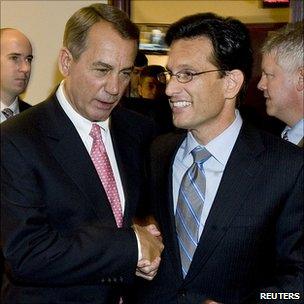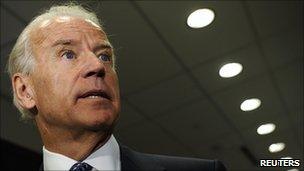US debt deal: What do the numbers mean?
- Published

Senior Republicans went through tough negotiations with the White House and their own party
Weeks of political infighting in Washington have produced a budget deal that aims to cut the US government budget deficit by $2.4 trillion (£1.5 trillion) over 10 years.
It sounds a big number but what does it actually mean?
Inevitably, the answer is complex and open to multiple interpretations. That, of course, is partly deliberate.
This is a deal that has to be sold to both Democrats and Republicans in the context of a political and economic debate that could hardly be more polarised.
The cuts come in two parts. First, as soon as the package becomes law procedures step in to cut government spending by around $900bn dollars.
Putting off the misery
Second, a congressional committee that includes both Republicans and Democrats will agree by the end of November further cuts of $1.5tn.
Those cuts must be approved by Congress by the end of December.
If that does not happen, an automatic mechanism applies that reduces spending by $1.2tn. Powerful incentives are built in to persuade the legislature to cut a deal.
Under the automatic mechanism, half the mandated cuts would hit the defence budget - something few Republicans want to happen.
The other half would include reductions in benefit entitlements for the poor, sick and elderly - payments dear to Democratic hearts.
This gives both sides good reason to agree a compromise on a package that is less draconian for the things they care about, but still delivers real cuts in federal spending.
However, the axe won't fall immediately under any scenario. Government budget plans remain entirely unchanged this year.
In 2012, spending falls by a relatively paltry $22bn, which is less than 1% of the total figure envisaged over 10 years. After that the reductions start getting serious.
The slow start is not simply about putting off the misery. With the US economy in a fragile state, there are strong reasons for not slashing the contribution of government spending - which supports jobs and revenues for businesses - too precipitously.
Indeed, many financial analysts - including those who want to see smaller government - support the delayed approach to austerity. It reduces the risk that drastic budget cuts will "kill the economy", to coin a popular phrase.
Swinging axe
But while the government may be trimming its budget plans, this does not necessarily mean it will actually cut spending.
The cuts are calculated from a base scenario of projected spending in future years as envisaged in March of this year. Essentially that means the government will slow the growth of spending that would otherwise have taken place if the austerity package had not been agreed.
In any one year up to 2021, once the programme gets going, the government will actually spend in the order of $100bn less than projected in March of this year. That may not seem like a lot of money in the context of total current US federal spending of around $3.5tn a year. That is why some conservative Republicans still don't like the deal.
But it is widely seen as a start, a psychological turning point, the moment after years of running up debts that the US government at last started to get its budget house in order.
One important issue, naturally, is where the axe will fall. The simple answer to that is we don't really know yet. The details have yet to be announced or in many cases even to be decided. One area we do know about is support for students going to college. They will receive less generous financial help from national government.
It is also clear that US defence spending will fall - around $350bn in the first phase of cuts. The headline rates of social security benefits and government support for medical care are likely to be protected.

Vice-President Joe Biden was directly involved in lengthy talks on the debt issue
Cuts in government aid for the less fortunate are expected to take more subtle forms that may be easier to defend politically.
There is of course nothing to stop future governments of whatever political stripe stepping up the level of austerity.
For financial markets, the details of what is in this particular package probably don't matter that much.
What the markets worried about was the prospect that failure to agree on lifting the debt ceiling would lead to Washington defaulting on existing debts.
That is now very unlikely to happen before the presidential election in 2012, giving the US an important breathing space.
- Published2 August 2011
- Published1 August 2011
- Published29 July 2011
- Published29 July 2011